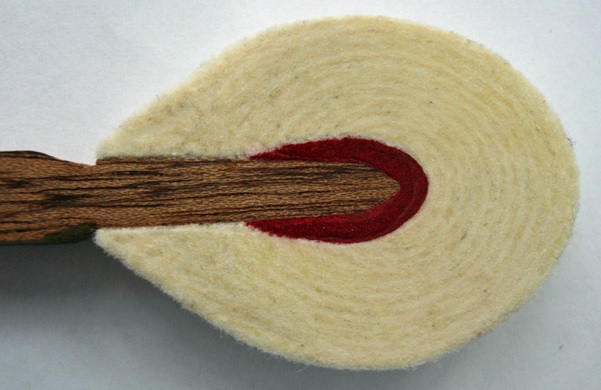The hammers strike the strings of the piano like mallets. Each note has a different sized hammer. Larger ones are used to excite larger strings and are located on the left side of the keyboard while smaller ones strike the high notes at the right side of the piano.
Hammers are made from sheep’s wool and there are many grades and kinds of wool. Virgin wool refers to fibers that have not been recycled and then reconstituted into new wool. Piano hammers are often double felted which generally is considered a higher grade of hammer (shown in red). Often terms of pounds are used to indicate the size and weight of hammers which refers to the initial sheet of wool before cutting. 14lb hammers are ‘lighter’ while 16 – 18 lb hammers are ‘weightier’. Note that many of the piano makers produce their own hammers in their factories while others import hammers from specialists.
Within each of the specialist companies there are also grades of hammers. For example Renner sells their “premium blue” as Piano Hammers2part of a series of hammers. Hammers are often reinforced by staples or “T-wires” to ensure they don’t come apart from the molding. The center wooden part of the hammer is called the molding. Traditionally they have been made from walnut, mahogany or hornbeam.
What are the steps in making hammers?
Hammer making looks to be very easy: Take some wood, some felt and put both into a hammer press and the hammers are finished. But it is not that easy. The whole procedure is much more complicated.
Everything starts with the felt. Felt is a natural product and based on Merino wool (Merino is a type of sheep with incredibly fine and high curled fibers) from South Africa, New Zealand or Australia. In these countries the Merino wool will be selected into different grades. For making hammer felt only a high grade wool fiber can be used. Then the raw wool comes into a cleaning process to Europe where all dirt, sand, dust, mud, vegetarian parts are washed out. This process is called carbonizing under the use of sulphuric acid. However, this acid is counter productive to hammer making as it has the undesired effect that a lot of natural lanolin will be also washed out (and the acid also is not good for the environment).
Natural lanolin (also called wool wax ) is very important to keep the natural resilience in the hammer felt which greatly affects piano tone. To retain this lanolin, Abel started the BIOFELT PROJECT 2003-2006 (sponsored by the European Union) with the result of a felt called NATURAL FELT which did away with harsh chemicals in the washing stage of felt making. This is a more natural product – not as white in color but incredibly versatile in sound. The use of this new Abel Natural Felt is responsible for great success in the piano business in our company.
Felt sheets will be then cut into strips after the sheets have been carefully controlled. The single wool fiber is still in a curled position. In the hammer press the felt will be pressed around the hammer moulding to stretch the wool fibers and to build up the resilience in the hammer felt. This procedure is the main secret of the hammer production. All hammer makers have a slightly different philosophy with this.
What’s the difference between cold and hot pressed hammers? How does that affect the hammer head?
Cold pressed means that the felt in the hammer press form will be pressed with no heat or almost no heat. This guarantees that the natural resilience of the wool fiber will be kept alive.
Hot pressed hammers in a heated press stabilize the wool fibers however it means that the natural resilience is gone and the hammer felt has lost its elasticity and the ability to create a maximum range of sound colours.
Why are hammers measured by weight? (for example 16lb hammers)
Hammers need a different weight because the pianos are different in size. The bigger the piano, the more weight is required to bring the long strings into vibration and to create maximum sound. For this reason especially the weight and size of the felt are important. A big hammer has a lot of concentrated resilience in the felt to stimulate the string to maximize sound producing energy.
How does the wooden moulding material affect the hammer?
Different hammer wood is important for different weight. Especially big pianos need larger felt with light hammer mouldings. The large felt is important to maximize sound vibration and the light woods like walnut and mahogany keep the total weight on a level which makes piano playing possible. So if you combine large felt hammers with light wooden mouldings, the overall weight is manageable at the keyboard.
What is the purpose of under-felt? Do colours designate manufacturer or something of function to identify a design or a time period?
When the first hammers were built the hammer makers did not have the same size felts available that we have today. It was necessary to make a hammer with different layers of underfelt and a thin top felt outside. Nowadays, we can make the same size of hammers with one layer of under-felt and a midsize top-felt or with no under-felt and a big size top-felt. The quality of the under-felt is always the same. But the under-felt can be dyed with different colours to show different brands.

Leave a Reply